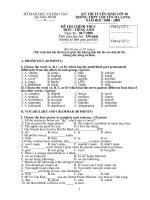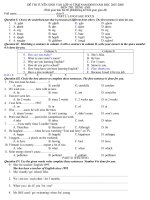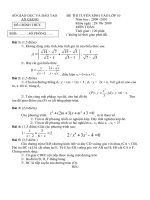de thi tuyen sinh 10 mon anh tinh an giang
Bạn đang xem bản rút gọn của tài liệu. Xem và tải ngay bản đầy đủ của tài liệu tại đây (143.76 KB, 4 trang )
<span class='text_page_counter'>(1)</span>SỞ GIÁO DỤC VÀ ĐÀO TẠO AN GIANG ………………… ĐỀ CHÍNH THỨC. ĐỀ THI TUYỂN SINH VÀO LỚP 10 TRƯỜNG THPT CHUYÊN THOẠI NGỌC HẦU Năm học : 2012-2013 Khóa ngày : 15 /06/ 2012 MÔN : TIẾNG ANH (Dành cho tất cả học sinh) Thời gian làm bài : 90 phút ( Không kể thời gian phát đề ) ( Thí sinh làm bài trên giấy thi; Đề thi có 2 trang ) Họ, tên thí sinh :……………………………………..số báo danh ………. I. Chọn từ ( tương ứng với A, B,C hoặc D ) mà phần gạch chân có cách phát âm khác với những từ còn lại ( 0,5 điểm ) 1. A. turns B. answers C. accepts D. enjoys 2. A. stopped B. lived C. listened D. wondered 3. A. happy B. many ['meni] C. fat D. man [mæn] 4. A. think B. three C. thank D. that II. Chọn ( tương ứng với A, B,C hoặc D ) mà trọng âm chính được đặt ở vị trí khác với những từ còn lại. ( 0,5 điểm ) 1. A. joyful B. lunar C. sticky D. aboard 2. A. impress B. gather C. publish D. cover 3. A. energy B. benefit C. appliance D. government 4. A. opinion B. evidence C. volcano D. destruction III. Điền vào chỗ trống bằng hình thức đúng của động từ cho trong ngoặc đơn ( 2 điểm ). 1. I ………………………..( lose ) my school-bag yesterday morning. lost 2. I often dream of ………………………..( go ) on a trip to Spain going 3. We …………………………( write ) to her twice this week. have written 4. If he ………………………..( learn ) hard, he will succeed in the examination. learns 5. I saw you yesterday. You ………………………( sit ) outside a cáfe. were sitting 6. Don’t forget ………………………….( do ) your homework tonight. to do (future action) 7. They left the garden after they ………………………..( gather ) many flowers. had gathered 8. I wish our teacher ……………………..( explain ) that lesson to us again tomorrow. would explain IV.Điền vào chỗ trống bằng hình thức đúng của từ cho trong ngoặc đơn ( 1 điểm ). 1. Mai works for a…………………bank in Hanoi. ( nation ) national 2. Traditionally, ao dai was …………….worn by both men and women ( frequent ) frequently 3. My sisiter is not satisfied with her ………………….for Tet . ( prepare) preparation 4. It’s ……………………to wear short skirts and faded jeans again. ( fashion ) fashionable V. Điền vào chỗ trống bằng một giới từ hoặc tiểu trạng từ thích hợp ( 1 điểm ). 1. She loves watching the stars ……………..night. at 2. We usually go to our home village at least once …………….the summer in 3. There will be a shortage of fresh water in a few decades unless we stop going …..wasting it. on 4. Turn ……….the TV for me , please .I want to watch the weather forecast. on VI. Xác định từ hoặc cụm từ có gạch dưới ( tương ứng với với A, B,C hoặc D ) sai về ngữ pháp tiếng Anh trong các câu dưới đây ( 1 điểm ). 1. The weather was lovely but we went out for a walk. A B C D 2. I liked the book which Tom told me to read it . A B C D 3. Between 1980 to 1990, the area was hit by five disastrous tornadoes. A B C D 4. The road to our village should be widening soon . A B C D VII. Chọn từ thích hợp nhất ( ứng với với A, B,C hoặc D ) để điền vào chỗ trống trong đoạn văn sau ( 1.25 điểm ). Chiang Mai, also sometimes written as “ Chiengmai”, is the largest and most culturally significant [sig'nifikənt] (quan trọng) city in Northern Thailand, and the capital of Chiang Mai Province. It is about 800 kilometers north of Bangkok, (1) …………..some of the highest mountains in the country. The city stands on the Ping river, a major tributary ['tribjutəri] (nhánh sông chính) of the Chao Phraya river . In recent years Chiang Mai has (2)…………..an increasingly modern city, although it lacks the cosmopolitan [,kɔzmə'pɔlitən] (chủ nghĩa thé giới) gloss (vẻ hào nhoáng) of Bangkok. (3)……….has many attractions for the thousands of forgein visitors who come to the city each year. Chiang Mai’s historic strength derived [di'raiv] (bắt nguồn từ) from its important strategic (chiến lược) [strə'ti:dʒik] (4)….……near a southern branch of the ancient Silk Road, and long before the modern influx ['inflʌks] (sự tràn vào) of foreign visitors the city served as an important (5)………for handcrafted [hænd,kra:ft] (thủ công) goods, umbrellas, jewellry ( particularly silver) and woodcarving. ['wudkɑ:viη] (tác phẩm chạm khắc gỗ) 1. A.among B. in C. on D. between 2. A. turned B. got C. made D. become 3. A. This B. It C. There D. Which 4. A. location B. area C. land D. sight 5. A. commerce B. position C. theater D. center VIII. Đọc kỹ đoạn văn sau và chọn từ thích hợp nhất ( ứng với A hoặc B, C, D ) để hoàn thành các câu hỏi dưới đây (1.25 điểm ). Pollution is the process of making air ,water, soil ,ect… dangerously dirty and not suitable for people to use. For example ● Air pollution is where there are gases in the air that is harmful, these gases come from objects or buildings like harmful smoke from factories, vehicles, automobiles ( cars, trucks, planes, boats ) and many more. ● Light pollution is unwanted light, such as the light of cities, street lights, and others which make it hard to see the stars..
<span class='text_page_counter'>(2)</span> ● Noise pollution is unwanted noise , such as the sound of cars in the city, loud boats/ ships, and trains . ● Water pollution is where there are things in the water that are harmful, such as crude oil (dầu thô) spilled from a shipwrecked ['∫iprek] tanker(đắm tàu chở dầu), smoke, poison, air pollution, and a lot of other things that are not human / plant /animal remains. 1. Air pollution comes from harmful………….from factories, vehicles , etc. A. trees B. parts C. smoke D. liquid 2. All of the following things cause light pollution except…………… A. traffic light B. light of cities C. street lights D. light of the moon. 3. Noise pollution is………. sound of cars, trains, planes etc. A. unwanted B. small C. interesting D. useful 4. Which of the following things doesn’t cause water pollution ? A. poison B. garbage C. marine life D. oil spilled from ships 5. Which of the following sentences is NOT true ? A. Air pollution comes from harmful gases. B. Light of the stars causes light pollution. C. Sound from a loud ship causes noise pollution. D. Water pollution can come from the land . IX. Hoàn thành câu thứ hai với các từ cho sẵn sao cho không đổi nghĩa so với câu gốc (1,5 điểm ) 1. The man was very kind. I talked to him last night The man to whom I talked last night was very kind. 2. “ I like this hotel very much” Alice told me that she liked that hotel very much 3. They didn’t look after the children properly. The children weren’t looked after properly 4. I cannot take a photo of us because I can’t find my camera. If I found/ could find my camera, I could take a photo of us 5. How long have you worked as a designer ? When did you start working as a designer? 6. Mr. Minh doesn’t have a red tie and he wants to have one very much. Mr. Minh wishes he had a red tie ĐÁP ÁN I. ( 0,5 điểm ) 1. C. 2. A. 3. B. 4. D. II ( 0,5 điểm ) 1. D. 2. A. 3. C. 4. B. III. ( 2 điểm ) 1. lost 5. were sitting. 2. going 6. to do. 3. have written 7. had gathered. 4. learns 8. would explain. IV. ( 1 điểm ) 1. national. 2. frequently. 3. preparation. 4. fashionable. V. ( 1 điểm ) 1. at. 2. in. 3. on. 4. on. VI. ( 1 điểm ) 1. C. 2. D. 3. A. 4. C. VII. (1,25 điểm ) 1. A. among. 2. D.become. 3. B. It. 4. A. location. 5. D. center. VIII. ( 1,25 điểm ) 1. C. 2. D. 3. A. 4. C. 5. B. IX. (1,5 điểm ) 1. The man to whom I talked last night was very kind. 2. Alice told me that she liked that hotel very much. 3. the children weren’t looked after properly. 4.If I found my camera, I could take a photo of us 5. When did you start working as a designer. 6. Mr. Minh wishes he had a red tie. ĐỀ THI TUYỂN SINH VÀO LỚP 10.
<span class='text_page_counter'>(3)</span> Năm học : 2012-2013 Khóa ngày : 15 /06/ 2012 MÔN :TIẾNG ANH I. Chọn từ ( tương ứng với A, B,C hoặc D ) mà phần gạch chân có cách phát âm khác với những từ còn lại ( 0,5 điểm ) 1. A. turns B. answers C. accepts D. enjoys 2. A. stopped B. lived C. listened D. wondered 3. A. happy B. many C. fat D. man 4. A. think B. three C. thank D. that II. Chọn ( tương ứng với A, B,C hoặc D ) mà trọng âm chính được đặt ở vị trí khác với những từ còn lại. ( 0,5 điểm ) 1. A. joyful B. lunar C. sticky D. aboard 2. A. impress B. gather C. publish D. cover 3. A. energy B. benefit C. appliance D. government 4. A. opinion B. evidence C. volcano D. destruction III. Điền vào chỗ trống bằng hình thức đúng của động từ cho trong ngoặc đơn ( 2 điểm ). 1. I ………………………..( lose ) my school-bag yesterday morning. 2. I often dream of ………………………..( go ) on a trip to Spain 3. We …………………………( write ) to her twice this week. 4. If he ………………………..( learn ) hard, he will succeed in the examination. 5. I saw you yesterday. You ………………………( sit ) outside a cáfe. 6. Don’t forget ………………………….( do ) your homework tonight. 7. They left the garden after they ………………………..( gather ) many flowers. 8. I wish our teacher ……………………..( explain ) that lesson to us again tomorrow. IV.Điền vào chỗ trống bằng hình thức đúng của từ cho trong ngoặc đơn ( 1 điểm ). 1. Mai works for a…………………bank in Hanoi. ( nation ) 2. Traditionally, ao dai was …………….worn by both men and women ( frequent ) 3. My sisiter is not satisfied with her ………………….for Tet . ( prepare) 4. It’s ……………………to wear short skirts and faded jeans again. ( fashion ) V. Điền vào chỗ trống bằng một giới từ hoặc tiểu trạng từ thích hợp ( 1 điểm ). 1. She loves watching the stars ……………..night. 2. We usually go to our home village at least once …………….the summer 3. There will be a shortage of fresh water in a few decades unless we stop going …..wasting it. 4. Turn ……….the TV for me , please .I want to watch the weather forecast. VI. Xác định từ hoặc cụm từ có gạch dưới ( tương ứng với với A, B,C hoặc D ) sai về ngữ pháp tiếng Anh trong các câu dưới đây ( 1 điểm ). 1. The weather was lovely but we went out for a walk. A B C D 2. I liked the book which Tom told me to read it . A B C D 3. Between 1980 to 1990, the area was hit by five disastrous tornadoes. A B C D 4. The road to our village should be widening soon . A B C D VII. Chọn từ thích hợp nhất ( ứng với với A, B,C hoặc D ) để điền vào chỗ trống trong đoạn văn sau ( 1.25 điểm ). Chiang Mai, also sometimes written as “ Chiengmai”, is the largest and most culturally significant city in Northern Thailand, and the capital of Chiang Mai Province. It is about 800 kolometers north of Bangkok, (1)…………..some of the highest mountains in the country. The city stands on the Ping river, a major tributary of the Chao Phraya river . In recent years Chiang Mai has (2)…………..an increasingly modern city, although it lacks the cosmopolitan gloss of Bangkok. (3)……….has many attractions for the thousands of forgein visitors who come to the city each year. Chiang Mai’s historic strength derived from its important strategic( 4)….……near a southern branch of the ancient Silk Road, and long before the modern influx of foreign visitors the city served as an important (5)………for handcrafted goods, umbrellas, jewellry ( particularly silver) and woodcarving. 1. A.among B. in C. on D. between 2. A. turned B. got C. made D. become 3. A. This B. It C. There D. Which 4. A. location B. area C. land D. sight 5. A. commerce B. position C. theater D. center VIII. Đọc kỹ đoạn văn sau và chọn từ thích hợp nhất ( ứng với A hoặc B, C, D ) để hoàn thành các câu hỏi dưới đây( 1.25 điểm ). Pollution is the process of making air ,water, soil ,ect… dangerously dirty and not suitable for people to use. For example ● Air pollution is where there are gases in the air that is harmful, these gases come from objects or buildings like harmful smoke from factories, vehicles, automobiles ( cars, trucks, planes, boats ) and many more. ● Light pollution is unwanted light, such as the light of cities, street lights, and others which make it hard to see the stars. ● Noise pollution is unwanted noise , such as the sound of cars in the city, loud boats/ ships, and trains ..
<span class='text_page_counter'>(4)</span> ● Water pollution is where there are things in the water that are harmful, such as crude oil spilled from a shipwrecked tanker, smoke, poison, air pollution, and a lot of other things that are not human / plant /animal remains. 1. Air pollution comes from harmful………….from factories, vehicles , etc. A. trees B. parts C. smoke 2. All of the following things cause light pollution except…………… A. traffic light B. light of cities C. street lights 3. Noise pollution is………. sound of cars, trains, planes etc. A. unwanted B. small C. interesting 4. Which of the following things doesn’t cause water pollution ? A. poison B. garbage C. marine life 5. Which of the following sentences is NOT true ? A. Air pollution comes from harmful gases. B. Light of the stars causes light pollution. C. Sound from a loud ship causes noise pollution. D. Water pollution can come from the land .. D. liquid D. light of the moon. D. useful D. oil spilled from ships. IX. Hoàn thành câu thứ hai với các từ cho sẵn sao cho không đổi nghĩa so với câu gốc (1,5 điểm ) 1. The man was very kind. I talked to him last night The man to………………………………………………………… 2. “ I like this hotel very much” Alice told me ………………………………………………………… 3. They didn’t look after the children properly. The children………………………………………………………… 4. I cannot take a photo of us because I can’t find my camera. If ………………………………………………………… 5. How long have you worked as a designer ? When did you start…………………………………………………………? 6. Mr. Minh doesn’t have a red tie and he wants to have one very much. Mr. Minh wishes . ………………………………………………………….
<span class='text_page_counter'>(5)</span>









